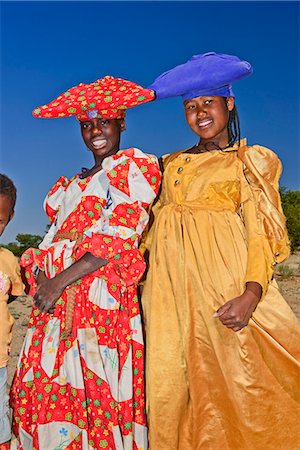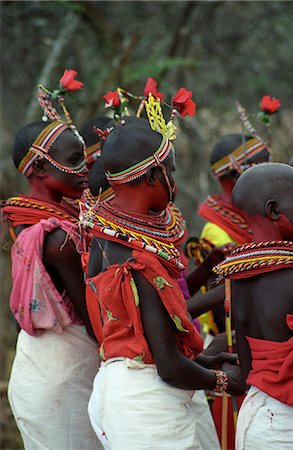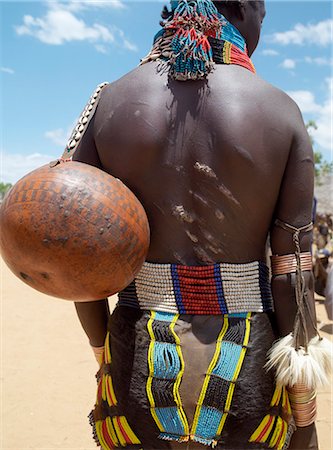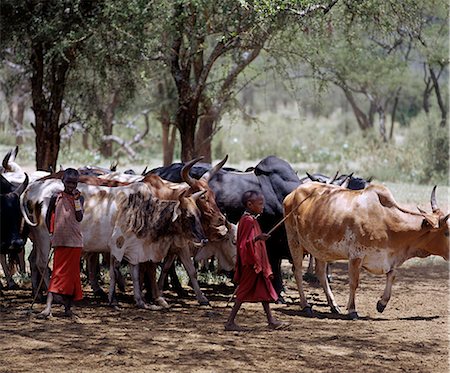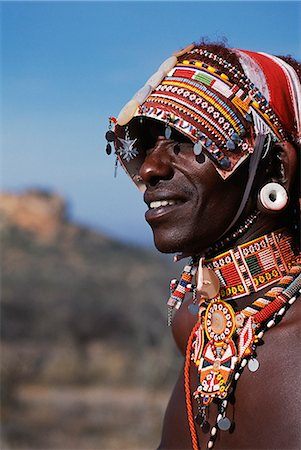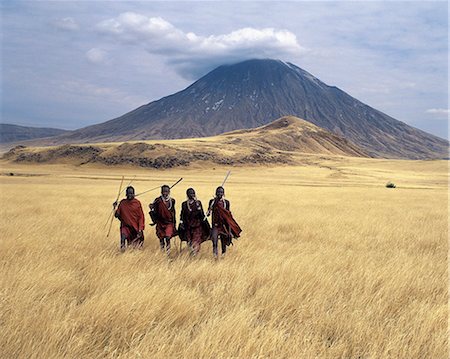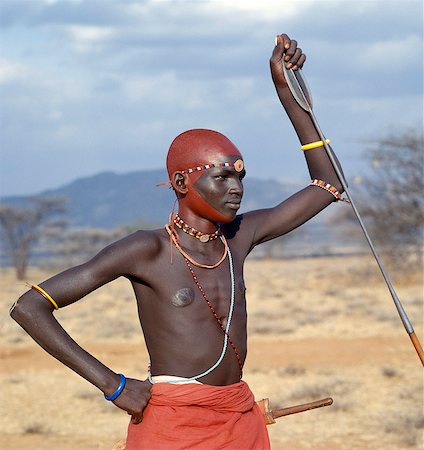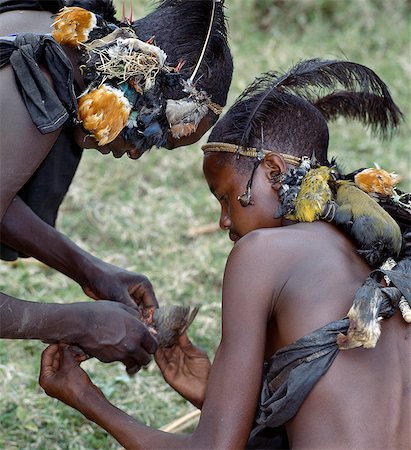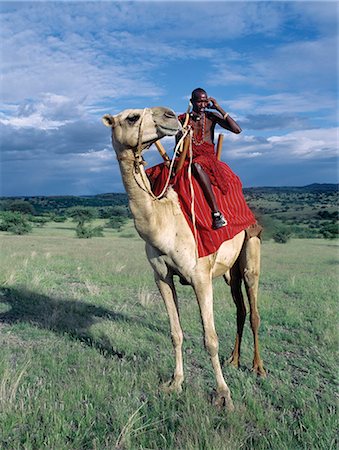-
Karo men paint each other in preparation for a dance in the village of Duss. A small Omotic tribe related to the Hamar,who live along the banks of the Omo River in southwestern Ethiopia,the Karo are renowned for their elaborate body painting using white chalk,crushed rock and other natural pigments.
Rights-Managed
-
Two young Dassanech boys sport elaborate clay hairdos at their settlement alongside the Omo River. Much the largest of the tribes in the Omo Valley numbering around 50,000,the Dassanech (also known as the Galeb,Changila or Merille) are Nilotic pastoralists and agriculturalists.
Rights-Managed
-
Kenya, Samburu District. Young Samburu girl in traditional beaded necklaces.
Rights-Managed
-
Kenya, Samburu District. A tourist attempting to jump as high as a Samburu warrior, in the dry river bed of the Ewaso Nyiro.
Rights-Managed
-
Kenya, Samburu District. Samburu warriors and young girls sing and dance in the dry river bed of the Ewaso Nyiro River.
Rights-Managed
-
An elder of the Karo tribe,a small Omotic tribe related to the Hamar,who live along the banks of the Omo River in southwestern Ethiopia. The Karo are renowned for their elaborate body painting using white chalk,crushed rock and other natural pigments. This man also has a clay hairdo typical of tribal elders. Like most adult males he carries a rifle.
Rights-Managed
-
A Datoga woman in traditional attire, which includes beautifully tanned and decorated leather dresses and coiled brass necklaces and ear ornaments.Extensive scarification of the face with raised circular patterns is not uncommon among women and girls.
Rights-Managed
-
A Datoga woman relaxes outside her thatched house.The traditional attire of Datoga women includes beautifully tanned and decorated leather dresses and coiled brass armulets and necklaces. Extensive scarification of the face with raised circular patterns is not uncommon among women and girls.
Rights-Managed
-
A Datoga woman relaxes outside her thatched house.The traditional attire of Datoga women includes beautifully tanned and decorated leather dresses and coiled brass armulets and necklaces.The Datoga live in northern Tanzania and are primarily pastoralists.
Rights-Managed
-
A beautifully decorated leather skirt of a Hamar woman.The Hamar are semi nomadic pastoralists of Southwest Ethiopia who live in harsh country around the Hamar Mountains of Southwest Ethiopia.Their whole way of life is based on the needs of their livestock.
Rights-Managed
-
A young Nyangatom woman carries her baby on her hip in an elaborately braided papoose. Her hair has been reddened with a mixture of ochre and animal fat. Typical of her tribe, she wears a calfskin skirt, multiple layers of bead necklaces and metal bracelets and amulets. The Nyangatom or Bume are a Nilotic tribe of semi nomadic pastoralists who live along the banks of the Omo River in south western
Rights-Managed
-
A Nyangatom woman wears multiple layers of beads in necklaces, an elaborately beaded calfskin skirt and metal bracelets, amulets and anklets. She is standing beside a temporary beehive construction of sticks, grass and leaves built to provide shade for her goats. The Nyangatom or Bume are a Nilotic tribe of semi-nomadic pastoralists who live along the banks of the Omo River in south western Ethio
Rights-Managed
-
A Nyangatom woman stands with her baby on her hip beside her grass hut in his temporary camp. Nyangatom married women wear elaborately beaded skirts which reach the ground at the back and often have panels of different coloured calkfskin sewn into the tail The Nyangatom or Bume are a Nilotic tribe of semi nomadic pastoralists who live along the banks of the Omo River in south western Ethiopia.
Rights-Managed
-
Two women from the NIIS hunter gatherer band talk together.The older woman is wearing a beautifully decorated leather cape.They live in the harsh environment of a vast expanse of flat sand and bush scrub country straddling the Namibia Botswana border.
Rights-Managed
-
A woman belonging to the NIIS hunter gatherer band wears a beautifully decorated leather cape.The NIIS live in the harsh environment of a vast expanse of flat sand and bush scrub country straddling the Namibia-Botswana border.
Rights-Managed
-
A brightly dressed Herero woman rests in the shade of a tree near her home.The origins of her elaborate dress and unique hat style can be traced back to 19th century German missionaries.
Rights-Managed
-
Tanzania, Zanzibar. Girls in brightly coloured cotton cloths, known as kangas, at Mkokotoni Market in northwest Zanzibar Island.
Rights-Managed
-
An old Kikuyu lady picks coffee.Taken in the 1960's,this photograph depicts a traditional form of dress and ear ornaments among Kikuyu women,which has completely disappeared.
Rights-Managed
-
Up to a year before his circumcision,a Samburu boy will style his hair in a distinctive 'pudding bowl' shape and often rub charcoal and fat into it.Uncircumcised boys are considered children whatever their age. They have no standing in the tribe and do not belong to an age-set.
Rights-Managed
-
Gabbra women dance at a gathering in the village of Kalacha. The Gabbra are a Cushitic tribe of nomadic pastoralists living with their herds of camels and goats around the fringe of the Chalbi Desert.
Rights-Managed
-
Gabbra women dance at a gathering in the village of Kalacha. The Gabbra are a Cushitic tribe of nomadic pastoralists living with their herds of camels and goats around the fringe of the Chalbi Desert.
Rights-Managed
-
Gabbra women sing and dance to celebrate a wedding. The traditional metal ornamentation on their heads is called malmal.
Rights-Managed
-
A Maasai boy herds his family's cattle near a waterhole in the foothills of Ol doinyo Orok (the Black Mountain). Childhood is very short in Maasailand; children begin to help their parents at a young age and may never attend school.
Rights-Managed
-
Two young Maasai girls help to herd their family's cattle near a waterhole in the foothills of Ol doinyo Orok (the Black Mountain). Childhood is very short in Maasailand; children begin to help their parents at a young age and may never attend school.
Rights-Managed
-
A Maasai elder herds his cattle near the foothills of Ol doinyo Orok (the Black Mountain).
Rights-Managed
-
A Maasai warrior resplendent with his long ochred braids tied in a pigtail watches over his family's cattle,spear in hand. The singular hairstyle of warriors sets them apart from other members of their society.
Rights-Managed
-
During their dances,Maasai warriors take turns to leap high in the air from a standing position without bending their knees. They achieve this by flexing their ankles in a seemingly effortless way .
Rights-Managed
-
Kenya,Kajiado,lpartimaro. Two Maasai warriors in full regalia. The headress of the man on the left is made from the mane of a lion while the one on the right is fringed with black ostrich feathers. Their traditional weaponry includes long-bladed spears and shields are made of buffalo hide.
Rights-Managed
-
One of the most important Maasai ceremonies is the eunoto when warriors become junior elders. Early one morning before the cattle are taken to pasture,their mothers shave their long ochred locks,which makes their appearance very different. One initiate can be seen blowing a Kudu horn trumpet.
Rights-Managed
-
During an eunoto ceremony when Maasai warriors become junior elders,their heads are shaved and they daub themselves with white clay.
Rights-Managed
-
Maasai warriors resplendent with long ochred braids relax and wait for the start of a ceremony. Red has always been their preferred colour.
Rights-Managed
-
The adornments of Samburu warriors change from generation to generation. In the 1990's cheap plastic flowers from China became fashionable to decorate their Ochred braids. This warrior has had his hair styled in the 'sunshade' look by having his braids at the front combed forward.
Rights-Managed
-
The adornments of Samburu warriors change from generation to generation. In the 1990's cheap plastic flowers from China became fashionable. This warrior is wearing several bracelets,which bear the Kenyan coat of arms.
Rights-Managed
-
The adornments of Samburu warriors change from generation to generation. In the 1990's cheap plastic flowers from China became fashionable.
Rights-Managed
-
A young Samburu man leads a donkey carrying the basic structure of a temporary home. The curved sticks will be tied together in a dome and covered with hides and woven mats to form a temporary shelter in a stock camp. Donkeys are widely used by the Samburu as beasts of burden.
Rights-Managed
-
Samburu moran (warrior) tries the feel of a shotgun at the end of a bird shooting safari.
Rights-Managed
-
A Hadza girl wearing a beaded headband and necklaces.The Hadzabe are a thousand-strong community of hunter-gatherers who have lived in the Lake Eyasi basin for centuries. They are one of only four or five societies in the world that still earn a living primarily from wild resources.
Rights-Managed
-
A young boy of the Datoga tribe crosses the plains east of Lake Manyara in Northern Tanzania. The Manyara escarpment (a western boundary wall of the Gregory Rift) is visible in the distance. The Datoga (known to their Maasai neighbours as the Mang'ati and to the Iraqw as Babaraig) live in northern Tanzania and are primarily pastoralists..
Rights-Managed
-
A young Datoga man tends his family's livestock on the plains east of Lake Manyara in Northern Tanzania.The Datoga (known to their Maasai neighbours as the Mang'ati and to the Iraqw as Babaraig) live in northern Tanzania and are primarily pastoralists..
Rights-Managed
-
An elder of the Karo tribe,a small Omotic tribe related to the Hamar,who live along the banks of the Omo River in southwestern Ethiopia. The Karo are renowned for their elaborate body painting using white chalk,crushed rock and other natural pigments. This man also has a clay hairdo typical of tribal elders. Like most adult males he carries a rifle.
Rights-Managed
-
An Afar girl has her attractive hairstyle embellished with buttons and beads,which is typical of the young girls of her tribe. Proud and fiercely independent,the nomadic Afar people live in the low-lying deserts of Eastern Ethiopia.
Rights-Managed
-
A young Maasai herdsboy controls his family's cattle at the Sanjan River to prevent too many animals watering at the same time.
Rights-Managed
-
A warrior of the Kisongo section of the Maasai with his long Ochred braids decorated with beaded ornaments. His broad armulet is typical of the Kisongo living in northern Tanzania where white is the preferred colour of their beadwork.
Rights-Managed
-
Maasai warriors take enormous trouble over their appearance especially their long hair,which is braided,Ochred and decorated with beaded ornaments. This singular hairstyle sets them apart from the rest of their community.
Rights-Managed
-
Two young Datoga men work wells on the east side of Lake Manyara to water their family's livestock. The man who draws water balances precariously on two poles.The Datoga (known to their Maasai neighbours as the Mang'ati and to the Iraqw as Babaraig) live in northern Tanzania and are primarily pastoralists.
Rights-Managed
-
A young Maasai girl wears a headband decorated with chains and cowrie shells that signifies her recent circumcision. Clitodectomy was commonly practiced by the Maasai but it is now gradually dying out.
Rights-Managed
-
Detail of a Maasai warrior's ear ornaments and other beaded or metal adornments. The Maasai practice of piercing ears in adolescence and gradually elongating the lobes is gradually dying out. This warrior's body and his long braids have been smeared with red ochre mixed with animal fat.
Rights-Managed
-
Turkana girls return home from a Waterhole with water containers made of wood. Their cloaks are goatskin embellished with glass beads.
Rights-Managed
-
A young Samburu girl dances during a wedding celebration. By arching her back and thrusting out her chest,she flicks her beaded necklaces up and down while dancing silently to the songs of the warriors. Her body and necklace have been smeared with red ochre,and her eyebrows blackened with charcoal dust mixed with animal fat.
Rights-Managed
-
Elaborate headdress and body adornments worn by Samburu moran (warrior).
Rights-Managed
-
A Dassanech girl braids her sister's hair at her village in the Omo Delta. Much the largest of the tribes in the Omo Valley numbering around 50,000,the Dassanech (also known as the Galeb,Changila or Merille) and Nilotic pastoralists and agriculturalists.
Rights-Managed
-
A Hamar woman at Turmi Market.The Hamar are semi-nomadic pastoralists of Southwest Ethiopia whose women wear striking traditional dress Skins are widely used for clothing and heavy metal necklaces,bracelets and anklets form part of their adornments. Cowries are also popular to embellish a woman's appearance.
Rights-Managed
-
A smart young Hamar youth at Turmi Market.The Hamar are semi-nomadic pastoralists who live in harsh country around the Hamar Mountains of Southwest Ethiopia. Their whole way of life is based on the needs of their livestock. Cattle are economically and culturally their most important asset.
Rights-Managed
-
Two Hamar girl in fashionable dress at Turmi market. The Hamar are semi-nomadic pastoralists of Southwest Ethiopia whose women and girls wear striking traditional dress. Skins are widely used for clothing and heavy metal necklaces,bracelets and anklets form part of their adornments. Cowries are also popular yet the sea is 500 miles from Hamar country.
Rights-Managed
-
A Hamar girl in traditional attire. Her leather skirt is made from the twisted strands of goatskin. Cowries are always popular to embellish a woman's or girl's appearance.The Hamar are semi-nomadic pastoralists who live in harsh country around the Hamar Mountains of Southwest Ethiopia.
Rights-Managed
-
A Datoga young man in traditional attire.His braids are embellished with beads and aluminium can openers.Many of his white plastic bracelets are beautifully decorated with abstract and geometrical designs; long ago these bracelets would have been made of ivory.
Rights-Managed
-
Deep Maasai wells at Loibor Serrit where cattle paths are cut deep into the soil to allow livestock nearer to the source of water. Despite this immense amount of manual labour.Four fit, young men are necessary to bring water to the stock troughs about 30 feet above the water level at the bottom of the hand dug wells.
Rights-Managed
-
Maasai warriors stride across the golden grass plains at the foot of Ol doinyo Lengai, the Maasais Mountain of God. Ol doinyo Lengai is the only active volcano in the Gregory Rift, an important section of the eastern branch of Africas Great Rift Valley system that stretches from northern Kenya into Northern Tanzania.
Rights-Managed
-
A Hadza hunter sits on a rock close to Lake Eyasi with Mount Oldeani rising in the distance.The Hadzabe are a thousand strong community of hunter gatherers who have lived in the Lake Eyasi basin for centuries.
Rights-Managed
-
A Hadza hunter wearing a baboon skin returns to camp with a haunch of impala over his shoulder. He killed the antelope with a metal tipped arrow that had been dipped in a fast acting vegetable poison extracted from the desert rose.
Rights-Managed
-
Kenya, Samburu District, Wamba.Immediately an initiate completes his lmuget loolbaa ceremony a month after his circumcision, he becomes a junior warrior of the Samburu tribe. From wearing a drab black cloak and carrying a bow and arrows, he proudly dons the ochred finery of a warrior, spear in hand. Overnight, he is transformed from a boy into a man, confident of his new role in tribal affairs.
Rights-Managed
-
A proud Samburu mother of two recently circumcised boys wears briefly their bird skin headdresses round her neck after they discard them during the lmuget loolbaa ceremony a month after their circumcision. She in turn will throw them away the same evening and ensure the familys cattle trample them under foot so that they will never be used or seen in public again.
Rights-Managed
-
Samburu initiates sing during the month after their circumcision. As their wounds heal, their dances become more energetic. Before long, they imitate the dances of the warriors which, hitherto, they have been forbidden to perform.They spend much of their time wandering in the countryside attempting to kill as many birds as they can with a club and four blunt arrows. When a bird is killed, it is sk
Rights-Managed
-
Samburu initiates skin a bird without the use of a knife.While their wounds heal for a month after circumcision, initiates spend their time wandering in the countryside attempting to kill as many birds as they can with a club and four blunt arrows. When a bird is killed, it is skinned, stuffed with dry grass and attached to the boy's headband by means of its beak.
Rights-Managed
-
A Samburu initiate takes aim at a bird with a blunt arrow.While their wounds heal for a month after circumcision, initiates spend their time wandering in the countryside attempting to kill as many birds as they can with a club and four blunt arrows. When a bird is killed, it is skinned without a knife, stuffed with dry grass and attached to the boys headband by means of its beak.
Rights-Managed
-
Kenya, South Horr, Kurungu.A Samburu youth after his circumcision. The day after he has been circumcised, the initiate must hang in his pierced earlobes copper ear ornaments that are normally worn by married women. His sponsors make him a new headdress of ostrich feathers fastened to a narrow band of plaited fibre, which fits tightly round his forehead like a sweatband.
Rights-Managed
-
A Samburu mother shaves her sons head outside her home the day before he is circumcised.Round her neck hangs his nchipi, the distinctive decoration of every boy who participates in the circumcision ritual. The strings of blue beads terminate in large bronze coloured wings of a torpedo shaped beetle, Sterocera hildebrandti.
Rights-Managed
-
A Samburu boy the day before his circumcision.He has daubed the right side of his face and body with white clay while drawing water from a source that never dries up. Each boy will carry for this purpose a new gourd shaped container made by his mother from hollowed out wood.
Rights-Managed
-
Mothers rub animal fat into their sons cloaks to make them supple. This task is performed shortly before the boys set out on an arduous journey to collect sticks, staves and gum to make bows, blunt arrows and clubs after their circumcision.
Rights-Managed
-
In the weeks leading up to their circumcision, Samburu boys must wear charcoal-blackened cloaks, which are made from three goatskins by their mothers.They also style their hair in a tuft at the back of their skulls.The elders of the tribe harangue them frequently.Uncircumcised boys are considered children whatever their age.
Rights-Managed
-
A Maasai warrior speaks on his mobile phone from the saddle of his camel near Lake Magadi in Kenyas Rift Valley Province.Mobile phones are a popular method of communicating with family and friends in remote areas of Kenya.
Rights-Managed
